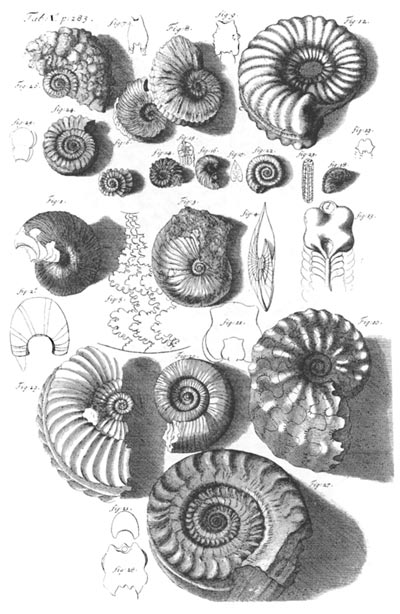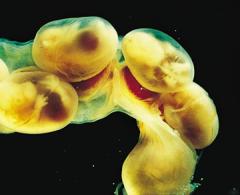
This Article From Issue
May-June 2003
Volume 91, Number 3
Page 210
DOI: 10.1511/2003.44.210
I occasionally receive notice that publications of mine on the subject of evolutionary theory have been quoted to promote an anti-evolutionist, creationist agenda: Recently it was the so-called Discovery Institute using my work in an attempt to limit the teaching of evolution in Ohio schools. At such times it is difficult to know whether to laugh or cry. These people read science so assiduously only to use it against us. But ultimately they are engaged in a deeper struggle for our hearts and minds that will never really go away: Is the universe totally explainable in scientific terms, or is there an ultimate, unknowable "mystery"?
One of the people who helped launch our evolutionary age was Robert Hooke (1635–1703). Hooke was a luminary in a brilliant age; his contemporaries were men like Robert Boyle, Christopher Wren, Anton van Leeuwenhoek, Gottfried Wilhelm Leibniz and of course Isaac Newton. They worked under the influence of Francis Bacon (1561-1626) who had decisively broken away from the medieval approach to science. The truth, whatever it might be, and however elusive, was not to be sought through Biblical revelation or Episcopal exegesis, nor in the authority of the ancient scholars such as Aristotle. Instead, for the modern scholar "all depends on keeping the eye steadily fixed upon the facts of nature and so receiving their images simply as they are."
In some regards, Hooke is best known as half of one of the great "odd couples" of science. Coming from a poor family, as a student at Oxford Hooke had to work as a servant. Robert Boyle was the wealthy son of the even more wealthy first Earl of Cork and never went to university. When Boyle settled in Oxford between 1656 and 1668, he employed Hooke to help him conduct his philosophical investigations on the nature (and laws) of gases. Hooke was his inventor-engineer, performing the famous air-pump experiments that proved the existence in air of some factor (later discovered and named oxygen) necessary for animal life.
In his later career, Hooke's creativity extended from clock mechanisms to the universal joint. He became surveyor to the City of London when Christopher Wren was the chief architect, and together they rebuilt the city after the great fire of 1666. Hooke and Wren experimented with microscopes, and from his observations of crude thin-sections of cork, Hooke devised the concept of (and the word) "cell."
In his great work Micrographia (1665), Hooke also published some of his most important thoughts about fossils, concluding, with Leonardo da Vinci and many ancient authors, that they must be the remains, variously trans-substantiated into rock, of once-living organisms. Then, with Lectures and Discourses of Earthquakes and Subterraneous Eruptions (1668–1700), he opened up a whole world of scientific explanation concerning the history of the earth and even outlined the basics of a rock cycle, thus preceding James Hutton by more than 100 years.

Robert Hooke
How, we might ask, could anyone in Restoration England get away with promoting such dangerous ideas about fossils and the earth? Part of the answer, of course, is that ideas alone are not a threat unless someone makes them so. Hooke's geology was not mature enough, and the context in which it was written was not supportive enough, for the forces of religion to do more than stir restively and warily. Today, the fact of an ancient and changing earth is so firmly established that its corollaries in terms of the evolution of life on earth seem almost irresistible. The stridency of modern anti-evolutionists surely arises not only from their subscription to a particular branch of religious fundamentalism, but also from the fact that evolution is now a full-blown science, no longer vulnerable to the charge of being a "hypothesis."
The Nature and Meaning of Fossils
Before Hooke and his contemporaries Steno (Nicolaus Stenson, who in 1669 published his classic Prodromus) and John Ray (Three Physico-Theological Discourses, 1692), the nature of fossils was legitimately in doubt. But the quality of the fossils that Hooke described in Micrographia and Earthquakes forced the issue that fossilization was a process:
Those Animals or Vegetable Substances they represent (were) converted into Stone, by having their Pores fill'd up with some petrifying liquid Substance . . . .
Most fossils are not of extant species; therefore, Hooke argued, some life forms have become extinct—a view at odds with The Book of Genesis (specifically, Chapter 1, verse 25). Hooke rejected the idea that fossils were simply evidence of Noah's Flood and concluded that the earth must be far older than the 6,000 years that Bishop Ussher had so famously inferred from his 1650 study of calendars and Biblical chronologies:
I think it will be evident that it could not come from the Flood of Noah since the duration that which was but about two hundred natural days, or half an year, could not afford time enough for the production and perfection of so many and so great and full grown Shells . . . besides the quantity and thickness of the Beds of Sand with which they are many times found mixed, do argue that there must needs be a much longer time of the Seas residence above the same . . . .
Another difficulty in interpreting fossils was that they were mostly "sea-shells" yet were found on mountains, far above sea-level. Hooke recognized that present day landforms are constantly being eroded and the resulting gravel, sand and silt washed inexorably into the sea. He saw also that, if the earth consisted of the remains of different ages, buried layer upon layer, then erosion could not have continued for eons without some offsetting effect. There must have been a process responsible for "the raising of very considerable Mountains out of a plain and level Country" (earthquakes, the heat at the center of the earth and change in the earth's axis were his explanations).
Hypothesis and Fact
Everything in Hooke's world view was opposite to the Biblical view: change instead of stasis, an old rather than a young Earth, a changing diversity of life instead of a fixed Creation. Hooke even speculated on the mutability of species. For him it was logical that if some species could die out over the course of the Earth's history, "there may be divers new kinds now, which have not been from the beginning." But what we now know as fact was then hypothesis. And there was no shortage of rival theories. In Robert Plot's Natural History of Oxford-Shire (1677), we find a tortured rehearsal of all the arguments against Hooke and Steno's view of fossils and for the idea that they were merely lapides sui generis—self-generated stones. A more daring hypothesis followed by Hooke's contemporary Edward Lhwyd was that fossils arose from the "seeds" of marine creatures that were carried by clouds from the sea to land, where they hatched deep within the rocks.
The problem for Hooke and other forward-thinkers was that if there had been conclusive independent evidence of the age of the earth and the relative ages of the different fossil-bearing layers, then fossils themselves would have been easy to accept. Alternatively, if there had been conclusive independent evidence of the true nature of fossils and of the processes that produce them, then the age of the Earth would readily have been accepted. Instead, as is almost always the case, both sides of the matter developed iteratively—here an advance, there a retreat. Radioisotopic dating of rocks (independent of fossils) and the discovery of the mechanisms of plate tectonics seem to have sealed the matter, although no doubt there is much more to discover.
The same chicken-egg difficulty of independent lines of evidence could be said to apply to modern evolutionary science. The ultimate conclusion one draws from the study of evolution (and thus the ultimate test of the science) is that life arose from non-life by natural processes. On the one hand, paleontology has shown conclusively that life has changed over time, and genetic analyses prove the relationship of all organisms through diversification of lineages. The three fundamentals of a Darwinian evolutionary mechanism—superfecundity, variation and selection—are readily demonstrated in living populations. All these lead us to predict that it will eventually be possible to demonstrate the evolution of life from non-life. On the other hand, if we had already demonstrated experimentally the assembly of self-replicating molecules from simple non-self-replicating molecules, we would have little difficulty in accepting an extrapolation from that to the evolution of diversity over time.
Interestingly, computer simulations are coming very close to demonstrating the origin of self-replicating molecules. And so the iterative process of evolutionary science continues, with much work still to be done.
The Anti-evolutionists
The last paragraph brings me back to the opening lines of this essay. Robert Plot, in 1677, used the fact that the fossils we call ammonites are "imperfect" versions of living Nautilus to argue that interpretations of fossils as the remains of real organisms must fail. Similarly, today anyone who admits that our current understanding of evolution is less than complete risks misrepresentation by anti-evolutionists and may be cited by them as evidence that the whole structure is a sham. (To see if your own work has been so treated, consult http://antievolution.org/people/wre/quotes)
Two hundred years after Hooke's Micrographia, in an effort to plug the dyke before evolutionism flooded the intellectual landscape, Philip Henry Gosse produced the mother of all ad hoc reasoning in his book Omphalos (1857). Greek for "the navel," the book's title was a reference to the old conundrum—did Adam have a navel? Gosse's answer was, yes; God created an Adam with a navel, and He created all the fossils of creatures that had never lived and the whole complex structure of the earth as we know it. He created trees with internal rings attesting to growth that had not occurred, rock strata that had never been laid down and streams with their sediment load from hills that had not been eroded. All the apparent evidence of a changing ancient earth was simply another part of God's bounteous creation. While this is almost an unbeatable argument—after all, how can you prove it to be false?—it is also nonsense: That which explains everything, explains nothing.
Following faithfully in Gosse's footsteps, some modern anti-evolutionists have developed a new version of the old ad hoc logic. It allows the option of granting the later course of evolutionary history but insists that the origin of life cannot be explained by evolution. According to this logic, large, complex molecules such as hemoglobin present an "irreducible" complexity that requires the operation of a Designing Intelligence, which they identify with God. It is hard to see this as science because it poses no testable hypotheses about what the Designing Intelligence is or how to investigate it, and it requires acceptance of belief in a negative—the un-evolveability of complex systems.
In the end, "irreducible complexity" also suffers from the same chicken-egg problem that I outlined above. If there were independent scientific proof of the existence and nature of God, His hand in creation would be more likely to be accepted. If the un-evolveability of complex molecules were somehow proved, there would be more support for a supernatural "intelligence." But the possibility of one says nothing about the probability of the other. And none of it constitutes the sort of hard-nosed search for explanations of material phenomena that Hooke and his contemporaries pioneered and that we call science.
© Keith Thomson

American Scientist Comments and Discussion
To discuss our articles or comment on them, please share them and tag American Scientist on social media platforms. Here are links to our profiles on Twitter, Facebook, and LinkedIn.
If we re-share your post, we will moderate comments/discussion following our comments policy.